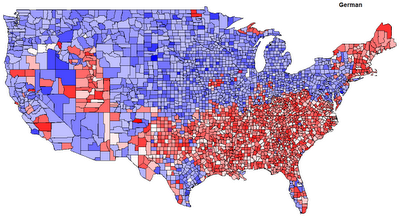|
Monday, November 16, 2009
Follow up post on the Isles, the distribution of German Americans.
25th quartile = 0.10 Median = 0.20 75th quartile = 0.30 Correlation(German, English) = -0.16 Correlation(German, American) = -0.74 Correlation(German, Irish) = 0.11 Correlation(German, Scots-Irish) = -0.31  Now let's exclude the South, where there are the fewest Germans. 25th quartile = 0.21 Median = 0.27 75th quartile = 0.39 Correlation(German, English) = -0.55 Correlation(German, American) = -0.47 Correlation(German, Irish) = -0.30 Correlation(German, Scots-Irish) = -0.37  FYI, the correlation between the frequency of German Americans as a proportion of the non-Hispanic white population and voting for Barack Obama is 0.21. The strong inverse relationship between the proportion of "Americans" and German Americans is in part a function of region. Germans are underrepresented in the Southeast quadrant of the country, where Americans are overrepresented. But that still punts the question as to why Americans define themselves in this way. I think this is plain history. Though a minority of German Americans have ancestors who arrived in the 18th century (including Dwight Eisenhower), the German American presence in the United States dates to the period between 1840 to 1890. This is recent enough that it probably explains the vociferousness of Germanophobia during World War I, when there was still a German language school system extant in the United States. Lawrence Welk was born in the German community of South Dakota, and German was his first language, explaining his slight accent (whether this was affected or not is controversial). By contrast, as documented in Albion's Seed, most of the ancestors of British Americans arrived in the 18th century. In fact, in New England it may be that most of the English origin population (and their descendant who spread into upstate New York and the Midwest) descend predominantly from 20-30,000 Puritan men and women who arrived in the Great Migration of 1620-1640 (when the religious climate in England was hostile to Puritanism). The ancestors of the Scots-Irish arrived in the 18th century or earlier, peaking in the decades before the American Revolution. Of course, as is obvious in previous maps, Americans tend to concentrate in the South, whose predominant wave of settlement was a century after New England. So antiquity is not all that is at work. It seems possible that the "Englishness" of New Englanders is in part a function of the fact that the immigration of Irish Catholics made their Protestant English identity more salient. By contrast, in the South the large numbers of blacks, or the relative nearness of blacks, allowed for the hybridization of the "Anglo-Celtic" white identity, which can be labelled as "American" (i.e., "real Americans"). It is interesting that the Germans in Texas still tend to identify as Germans. For Texas: Correlation(German, American) = -0.60 Correlation(German, English) = 0.16 Correlation(German, Scots-Irish) = -.24 Correlation(American, English) = -0.37 Correlation(American, Scots-Irish) = -0.36 Remember that Germans who settled Texas were generally recent immigrants from Germany. By contrast, the Anglos who settled Texas were secondary immigrants from the South, often regions of later settlement such as Tennessee, settled from the Atlantic states such as South Carolina in the first place. Addendum: As some commenters have noted, there is also a likely bias in terms of the most recent immigrant lineage. So in the many individuals with both German and Anglo-Celtic ancestry, the former is likely to have been more recent and memorable. Labels: politics |



